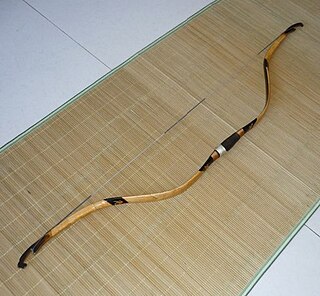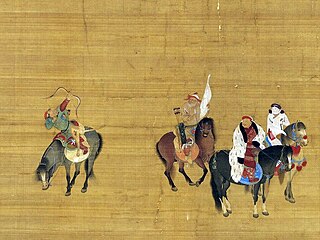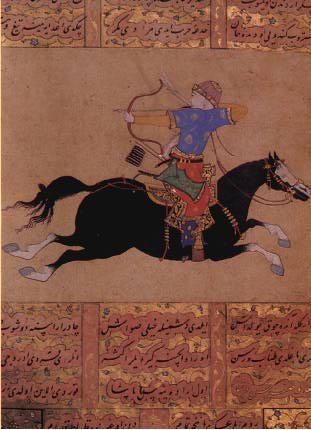Related Research Articles

Archery is the sport, practice, or skill of using a bow to shoot arrows. The word comes from the Latin arcus, meaning bow. Historically, archery has been used for hunting and combat. In modern times, it is mainly a competitive sport and recreational activity. A person who practices archery is typically called an archer, bowman, or toxophilite.

The bow and arrow is a ranged weapon system consisting of an elastic launching device (bow) and long-shafted projectiles (arrows). Humans used bows and arrows for hunting and aggression long before recorded history, and the practice was common to many prehistoric cultures. They were important weapons of war from ancient history until the early modern period, when they were rendered increasingly obsolete by the development of the more powerful and accurate firearms. Today, bows and arrows are mostly used for hunting and sports.

A composite bow is a traditional bow made from horn, wood, and sinew laminated together, a form of laminated bow. The horn is on the belly, facing the archer, and sinew on the outer side of a wooden core. When the bow is drawn, the sinew and horn store more energy than wood for the same length of bow. The strength can be made similar to that of all-wood "self" bows, with similar draw-length and therefore a similar amount of energy delivered to the arrow from a much shorter bow. However, making a composite bow requires more varieties of material than a self bow, its construction takes much more time, and the finished bow is more sensitive to moisture.
Shams ad-Dīn Abū ʿAbd Allāh Muḥammad ibn Abī Bakr ibn Ayyūb az-Zurʿī d-Dimashqī l-Ḥanbalī , commonly known as Ibn Qayyim al-Jawziyya or Ibn al-Qayyim for short, or reverentially as Imam Ibn al-Qayyim in Sunni tradition, was an important medieval Islamic jurisconsult, theologian, and spiritual writer. Belonging to the Hanbali school of Salafi, of which he is regarded as "one of the most important thinkers," Ibn al-Qayyim was also the foremost disciple and student of Ibn Taymiyya, with whom he was imprisoned in 1326 for dissenting against established tradition during Ibn Taymiyya's famous incarceration in the Citadel of Damascus.

The Mongol bow is a type of recurved composite bow historically used in Mongolia, and by the horse archers of the Mongol Empire. "Mongol bow" can refer to two types of bow. From the 17th century onward, most of the traditional bows in Mongolia were replaced with the similar Manchu bow which is primarily distinguished by larger siyahs and the presence of prominent string bridges.

A thumb ring is a ring meant to be worn on one's thumb. Most commonly, thumb rings are used as an archery equipment designed to protect the thumb pulp from the bowstring during a thumb draw, and are made of leather, stone, horn, wood, bone, antler, ivory, metal, ceramics, plastic or glass. It usually fits over the distal phalanx of the thumb, coming to rest at the distal edge of the interphalangeal joint. Typically a flange extends from the ring to cover the thumb pulp, and may be supplemented by a leather extension.

Turkish archery is a tradition of archery which became highly developed in the Ottoman Empire, although its origins date back to the Eurasian Steppe in the second millennium BC.

Archery, or the use of bow and arrows, was probably developed in Africa by the later Middle Stone Age. It is documented as part of warfare and hunting from the classical period until the end of the 19th century, when bow and arrows was made functionally obsolete by the invention and spread of repeating firearms.
Qusta ibn Luqa, also known as Costa ben Luca or Constabulus (820–912) was a Melkite Christian physician, philosopher, astronomer, mathematician and translator. He was born in Baalbek. Travelling to parts of the Byzantine Empire, he brought back Greek texts and translated them into Arabic.
A laminated bow is an archery bow in which different materials are laminated together to form the bow stave itself. Traditional composite bows are normally not included, although their construction with horn, wood, and sinew might bring them within the above definition.

A bowstring joins the two ends of the bow stave and launches the arrow. Desirable properties include light weight, strength, resistance to abrasion, and resistance to water. Mass has most effect at the center of the string; one gram (0.035 oz) of extra mass in the middle of the string slows the arrow about as much as 3.5 grams (0.12 oz) at the ends.
The Rashidun army was the core of the Rashidun Caliphate's armed forces during the early Muslim conquests in the 7th century. The army is reported to have maintained a high level of discipline, strategic prowess and organization, granting them successive victories in their various campaigns.
A bow draw in archery is the method or technique of pulling back the bowstring to store energy for the bow to shoot an arrow. The most common method in modern target archery is the Mediterranean draw, which has long been the usual method in European archery. Other methods include the pinch draw and the Mongolian or "thumb" draw. In traditional archery practice outside Western Europe the variations of the thumb draw are by far the most dominant draw types, with the Mediterranean draw restricted to the Olympic style of target archery.

In archery, a recurve bow is one of the main shapes a bow can take, with limbs that curve away from the archer when unstrung. A recurve bow stores more energy and delivers energy more efficiently than the equivalent straight-limbed bow, giving a greater amount of energy and speed to the arrow. A recurve will permit a shorter bow than the simple straight limb bow for given arrow energy, and this form was often preferred by archers in environments where long weapons could be cumbersome, such as in brush and forest terrain, or while on horseback.

Furūsiyya is an Arabic knightly discipline and ethical code developed in the Middle Ages. It was practised in the medieval Muslim world from Afghanistan to Muslim Spain, and particularly during the Crusades and the Mamluk period. The combat form uses martial arts and equestrianism as the foundation.

In archery, a release aid, mechanical release, or release is a device that helps to fire arrows more precisely, by using a trigger to release the bowstring, rather than the archer's fingers. It is used to make the release of the bowstring quicker and reducing the amount of torque put onto the bowstring from the archer's fingers.
Abū Naṣr Alī ibn Hibat Allāh ibn Ja'far ibn Allakān ibn Muḥammad ibn Dulaf ibn Abī Dulaf al-Qāsim ibn 'Īsā al-Ijlī, surnamed Sa’d al-Muluk and known as Ibn Mākūlā was a highly regarded Arab muḥaddith and historian who authored several works. His magnum opus was his biographical-genealogical history on etymology and orthography of Islamic names, Al-Ikmāl.
The Kitāb fī maʿrifat ʿilm ramy al-sihām, called the Maʿrifa for short, is an Arabic treatise on archery written by Ḥusayn al-Yūnīnī around 1320. It was intended for those entering the archers' guild in the Mamluk Sultanate. It is preserved in three manuscripts.
Al-Basus was a female poet of pre-Islamic Arabia. She is remembered for her poetry which incited her nephew into murdering Kulaib ibn Rabiah, starting the Basus War that lasted for 40 years.
References
- ↑ Paterson, W. F. 1966. "The Archers of Islam." Journal of the Economic and Social History of the Orient. Vol. 9, No. 1/2 (Nov., 1966), pp. 69-87.
- ↑ Marcelo Muller (15 September 2012). "XLII. On thumb-tips and the various kind thereof, from: Arab Archery, by N.A. Faris and R.P. Elmer, 1945". archerylibrary.com.
- ↑ "Arab Archery". www.archerylibrary.com. 2019-11-11. Retrieved 2022-08-23.
- ↑ KUNSELMAN, DAVID E. 2007. ARAB-BYZANTINE WAR, 629-644 AD. Page 53.
- ↑ Soar, Hugh. 2018. "The Incendiary Arrow." Primitive Archer. Volume 26 (1), pages 18-20.
- ↑ Muhammad: Islam’s First Great General. By Richard A. Gabriel. 2012. University of Oklahoma Press. Page 34.
- ↑ http://www.worldarchery.org/OTHEREVENTS/Others/2011/Doha-ArabGames/TabId/1124/ArtMID/1567/ArticleID/470/Successful-Archery-Competition-at-the-12th-Arab-Games-.aspx [ dead link ]
- 1 2 Jallon 1980, p. 25.
- ↑ Jallon 1980, p. 31.
- ↑ Jallon 1980.
- ↑ Translated in Latham and Pateson 1970.
- ↑ Ibn Qayyim al-Jawzīyah, Muḥammad ibn Abī Bakr. kitab ʻuniyat al-ṭullāb fī maʻrifat al-rāmī bil-nushshāb. [Cairo?]: [s.n.], 1932. OCLC: 643468400.
- ↑ Translated in Faris and Elmer 1945.